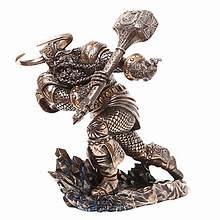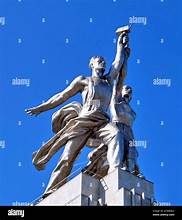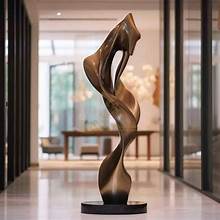Ikoku with Hammer Bronze Sculpture: A Glimpse into the Art of Crafting Masterpieces

Introduction to the Art of Ikoku with Hammer Bronze Sculpture
The ikoku with hammer bronze sculpture is an extraordinary example of the mastery and intricacy involved in bronze sculpting. With its origins rooted in diverse cultural histories and a technique involving hammering and shaping molten bronze into complex forms, the ikoku with hammer bronze sculpture offers insight into the craftsmanship of ancient and contemporary artists alike. This article delves into the techniques, cultural significance, and modern interpretations of this compelling form of art.
Table of Contents
The Historical Background of Ikoku with Hammer Bronze Sculpture
The practice of bronze sculpting dates back millennia. Bronze, an alloy of copper and tin, has been used for everything from tools to weaponry and, importantly, artistic creations. The ikoku with hammer bronze sculpture finds its place within the tradition of metalworking art forms, particularly within cultures that valued the craftsmanship of artisans in creating monumental sculptures. These sculptures could depict gods, leaders, animals, or mythological beings, reflecting the values and traditions of the society that produced them.
In the context of the ikoku with hammer bronze sculpture, the method of hammering the molten metal into the desired shape is what distinguishes it from other forms of casting. Artists would heat the bronze to a liquid state, pour it into molds, and then, using a specialized hammer, gradually shape and smooth the surface. The end result is a dynamic piece that embodies both the rawness of its creation and the fine details achieved through labor-intensive techniques.
The Techniques Behind Ikoku with Hammer Bronze Sculpture
Creating an ikoku with hammer bronze sculpture involves a number of detailed steps. The first and most fundamental step is the casting process. After obtaining the necessary materials, artists start by melting the bronze in a furnace until it becomes liquid. This molten bronze is then poured into pre-made molds, which can either be made from clay, sand, or a similar material that can withstand high temperatures.
Once the basic form has been cast, the next step is where the magic of the ikoku with hammer bronze sculpture truly begins: the hammering process. Using a variety of tools, the artist hammers the metal while it is still hot to refine the shape and surface texture. This step is extremely time-consuming, requiring patience and skill, as the artist needs to balance force with precision. Unlike traditional casting methods where the sculpture is often created through a single mold, the ikoku with hammer bronze sculpture is uniquely shaped by human touch and force.
The hammering method used in the ikoku with hammer bronze sculpture not only defines the shape of the sculpture but also imparts unique textures and features to the surface. The marks left by the hammer can become part of the aesthetic appeal of the sculpture, contributing to its distinctive visual language.
Cultural Significance of Ikoku with Hammer Bronze Sculpture

The ikoku with hammer bronze sculpture is more than just a form of artistic expression; it is also a significant cultural artifact. In many cultures, bronze sculptures are used as representations of power, divinity, or human emotion. For example, in ancient civilizations like the Greeks and Romans, bronze sculptures were often used to immortalize gods and rulers, ensuring their legacy would be remembered for centuries.
Similarly, in Africa, bronze sculptures created using hammering techniques have been historically used to convey the status and achievements of kings and chieftains. The ikoku with hammer bronze sculpture in this context would be both an artistic and a political statement, embodying the power and importance of the individual depicted.
In modern times, the ikoku with hammer bronze sculpture continues to serve as a reflection of the artist’s creative vision. Sculptors often use this technique to push the boundaries of traditional art, using the raw energy of hammering and molten metal to express dynamic forms and ideas. This modern interpretation gives the ancient practice new life and relevance, as contemporary artists embrace the challenge of working with bronze while also exploring new themes and concepts.
Notable Artists and Works in the Ikoku with Hammer Bronze Sculpture Tradition
Many artists have contributed to the ongoing evolution of the ikoku with hammer bronze sculpture tradition. Some have looked to ancient techniques for inspiration, while others have sought to innovate and introduce fresh perspectives to the medium. One such artist is the renowned sculptor Giacometti, who famously utilized similar hammering methods in his works to create elongated and skeletal human figures.
Another key figure in this tradition is Benin’s Court Artists, who have crafted striking bronze works for centuries. The ikoku with hammer bronze sculpture technique is part of a long-standing artistic heritage in the Kingdom of Benin, where artists have been using complex casting methods, including the hammering technique, to create sculptures of royal figures, animals, and scenes of daily life. These works, often found in the royal palaces, are integral to the understanding of Benin’s history and culture.
In the contemporary art world, sculptors like David Smith have also incorporated aspects of the ikoku with hammer bronze sculpture in their own works. Smith’s monumental sculptures, while made with modern techniques, evoke the same tactile presence and power that hammering molten metal imparts to bronze sculptures.
The Unique Aesthetic of Ikoku with Hammer Bronze Sculpture
What sets the ikoku with hammer bronze sculpture apart from other forms of sculpture is its deeply tactile nature. The hammering process leaves behind subtle textures that can create a sense of movement, depth, and emotion within the sculpture. These textures are not merely decorative; they are integral to the piece’s meaning, as they represent the artist’s direct interaction with the material.
Furthermore, the act of hammering molten bronze into shape creates a raw, almost primal energy that is present in the finished sculpture. The ikoku with hammer bronze sculpture often radiates a sense of strength and fluidity, where the marks of the hammer can be interpreted as an expression of the artist’s intention and emotional input.
The visual impact of the ikoku with hammer bronze sculpture can vary greatly depending on the artist’s approach. Some pieces may emphasize sharp, angular lines, while others focus on smooth, rounded surfaces. The play of light and shadow on the hammered surfaces adds to the dynamic nature of the sculpture, creating different effects depending on the viewing angle and lighting conditions.
The Role of Ikoku with Hammer Bronze Sculpture in Modern Art

In the contemporary art world, the ikoku with hammer bronze sculpture has taken on a new role. Artists are not only using it to reflect historical traditions but also to experiment with modern issues, such as identity, politics, and the environment. The process of hammering molten bronze provides a unique opportunity for artists to bring personal expression and physical energy into the artwork.
Many modern sculptors view the ikoku with hammer bronze sculpture as an embodiment of transformation, both for the material itself and for the society that views it. The hammering process can be seen as a metaphor for the human experience—one of constant shaping, refinement, and renewal. Artists use this method to explore the relationship between the individual and the collective, the tangible and the abstract.
Moreover, the continued popularity of the ikoku with hammer bronze sculpture underscores its relevance in the modern era. Despite the advancement of digital art and new technologies, traditional forms like the ikoku with hammer bronze sculpture continue to resonate with audiences. These sculptures possess a timeless quality, as they combine age-old techniques with contemporary themes and interpretations.
The Future of Ikoku with Hammer Bronze Sculpture
The future of the ikoku with hammer bronze sculpture appears bright, as both new generations of artists and collectors embrace the art form. The unique qualities of hammered bronze—its tactile nature, the imprint of the artist’s effort, and its rich historical context—make it an enduring and dynamic medium for expression. As the world of art continues to evolve, the ikoku with hammer bronze sculpture is likely to remain a vital part of the conversation surrounding cultural heritage and innovation in the arts.
Additionally, the ikoku with hammer bronze sculpture is making its mark in the world of contemporary installations and public art. As more public spaces and galleries embrace large-scale sculptures, the raw, dynamic forms created through this method offer a powerful visual statement. The future of this tradition promises not only a continuation of its cultural significance but also an expansion of its artistic possibilities.
Also read Steven Maranga Nyambega: A Rising Star in Kenya’s Innovation and Technology Scene
Conclusion: Celebrating the Ikoku with Hammer Bronze Sculpture
In conclusion, the ikoku with hammer bronze sculpture stands as a testament to the ingenuity, patience, and vision of the sculptor. Through its intricate hammering process, the artist can shape not only the metal but also the narrative and emotion embedded in the piece. Whether through historical representations of power or modern explorations of human experience, the ikoku with hammer bronze sculpture is a form of art that continues to captivate and inspire.
As this tradition evolves, it remains deeply connected to the values of craftsmanship, cultural expression, and the timeless human desire to create beauty from raw materials. The ikoku with hammer bronze sculpture will undoubtedly continue to shine as an enduring example of the power of art to transcend time, place, and medium.




